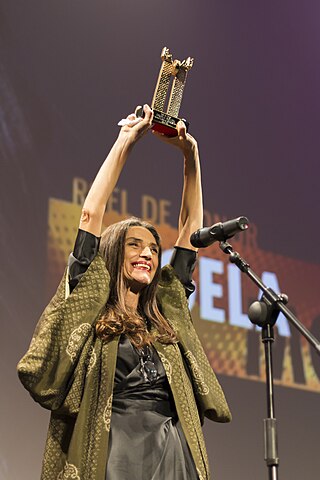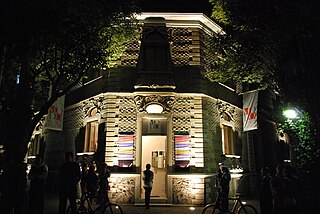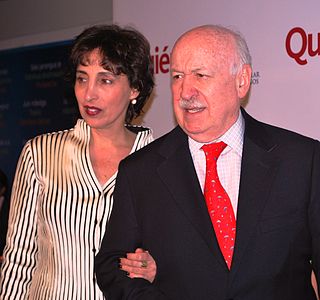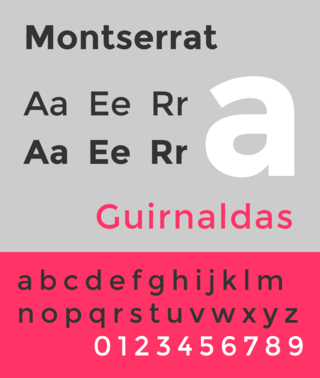
Café Tacvba is a band from Naucalpan de Juárez, State of Mexico. The group gained popularity in the early 1990s. They were founded in 1989, before they had the current lineup of Rubén Isaac Albarrán Ortega, Emmanuel del Real Díaz, José Alfredo "Joselo" Rangel Arroyo, and Enrique "Quique" Rangel Arroyo:, their friend Roberto Silva played the keyboards for a short period of time. Since the Cuatro Caminos World Tour, Luis "El Children" Ledezma has played the drums in every concert but is not considered an official member of the band, as well as Ramiro Del Real Díaz, who joined the band as a support musician playing the guitar since 2015.

Sir Misha Black was a British-Azerbaijani architect and designer. In 1933 he founded with associates in London the organisation that became the Artists' International Association. In 1943, with Milner Gray and Herbert Read, Sir Misha Black founded Design Research Unit, a London-based Architectural, Graphic Design and Interior Design Company.

Ángela Molina Tejedor is a Spanish actress. Aside from her performances in Spanish films, she has starred in multiple international productions, particularly in a number of Italian films and television series.

Colonia Roma, also called La Roma or simply, Roma, is a district located in the Cuauhtémoc borough of Mexico City just west of the city's historic center, and in fact is no longer a single colonia (neighbourhood) but now two officially defined ones, Roma Norte and Roma Sur, divided by Coahuila street.

Fernando Castro Pacheco was a Mexican painter, engraver, illustrator, printmaker and teacher. As well as being known for traditional artistic forms, Castro Pacheco illustrated several children’s books and produced works in sculpture. He is more popularly known for his murals that invoke the spirit and history of the Mexican people. His works evoke a unique use of color and form.
Félix Juan Alberto Beltrán Concepción was a Cuban artist and one of the most important Latin American designers. He had a career as a graphic designer, painter, draftsman, and engraver.

Leopoldo Flores was a Mexican artist mostly known for his murals and other monumental works which are concentrated in the city of Toluca, State of Mexico. He was born into a poor family in rural State of Mexico, but his artistic ability was evident early and he was able to attend the Escuela Nacional de Pintura, Escultura y Grabado "La Esmeralda" and receive a scholarship to study in Paris. His best known works are the Cosmovitral a large work in stained glass and the Aratmósfera, a “land art” piece both located in Toluca. The first is used as a symbol for the State of Mexico and the latter dominates the main stadium and the hill behind it at the main campus of the Universidad Autónoma del Estado de México (UAEM). He received a number of recognitions of his work from the State of Mexico and an honorary doctorate from the UAEM, which also founded the Museo Universitario Leopoldo Flores to house and promote his work. Despite advanced Parkinson's disease, until his death Flores was still an active artist.

Sebastián is a Mexican sculptor best known for his monumental works of steel and/or concrete in both Mexico and abroad. These include a number of “gate” sculptures such as the Gran Puerta a México in Matamoros, Tamaulipas but his most famous sculpture is the “Caballito” located in downtown Mexico City. His works are found in various countries outside Mexico, such as Japan where two are now used as city symbols.
Francisco Díaz de León was a Mexican graphic artist, notable for pioneering much of modern Mexican graphic arts. He spent his childhood around books and when he studied art in Mexico City, he specialized in engraving and illustration. He spent his career illustrating books, magazines and more, reviving techniques such as dry point and introducing new techniques and styles such as the use of color and linoleum printing. He was also a noted arts education, directing several schools including the Escuela Mexicana de las Artes del Libro, which he founded. He was a founding member of the Academia de Artes and a member of the Salón de la Plástica Mexicana. In 1969 he received the Premio Nacional de Artes for engraving.

The Museo del Objeto del Objeto, or MODO, is a museum in Mexico City and the first museum in Mexico dedicated to design and communications. It was opened in 2010 based on a collection of commercial packaging, advertising, graphic arts, common devices and many other objects dating back to 1810 collected by Bruno Newman over more than 40 years. The museum is dedicated to the preservation of its collection of more than 30,000 items from two centuries and to the research in the history of design and communications.

Bruno Newman is a businessman from Mexico City. He is the founder and co director of Zimat Consultores, a publisher, photographer and the founder of the Museo del Objeto del Objeto (MODO).
Ángel Bracho was a Mexican engraver and painter who is best known for his politically themed work associated with the Taller de Gráfica Popular; however he painted a number of notable murals as well. Bracho was from a lower-class family and worked a number of menial jobs before taking night classes for workers at the Escuela Nacional de Artes Plásticas. Even though he had only four years of primary school, he then studied as a full-time student at the university. His art career began working with Diego Rivera on the painting of the Abelardo L. Rodríguez market in Mexico City. He was a founding member of the Taller de Gráfica Popular, making posters that would become characteristic of the group. His graphic design work is simple, clean and fine dealing with themes related to social struggles with farm workers, laborers and Mexican landscapes.

Adolfo Mexiac was a Mexican graphic artist, known principally for his politically and socially themed work, especially with the Taller de Gráfica Popular and with fellow graphic artist Leopoldo Méndez. He also painted several murals, the most important of which deals with the history of human law at the University of Colima. In 2011, a “national homage” was held for the artist at the Museo de la Estampa in Mexico City.
Jesús Álvarez Amaya was a Mexican painter and graphic artist, mostly known for mural work and his graphic work as head of the Taller de Gráfica Popular, which he led from 1967 until his death. His murals can be found in various parts of the country and his art mostly have social and political themes.

Vicente Gandía was a Mexican artist of Spanish origin who is best known for his depictions of nature and buildings. He originally trained to be an architect but abandoned this in favor of art, but with his art career beginning by drawing interiors. His major break came in 1968, with international expose which led to greater demand for his work. Recognitions for his art include membership in the Salón de la Plástica Mexicana, two awards from the same institution, a homage to the artist sponsored by the Instituto Nacional de Antropología e Historia while still alive and two others after his death, one with the Festival Internacional Cervantino.
José Reyes Meza was a Mexican painter, costume and set designer, who helped to found a number of cultural institutions in Mexico. Reyes Meza began his artistic career principally in theater, although he was an active painter and even bullfighter in his early days. Painting became prominent starting in the 1970s, working on murals in various parts of Mexico as well as exhibiting canvas works in Mexico and abroad. The artist is a founding member of the Salón de la Plástica Mexicana and his work has been acknowledged by tributes, various awards and an art museum in Nuevo Laredo named after him.
The College of Medallists is an association of recipients of The Sir Misha Black Medal for Distinguished Services in Design Education. Misha Black (1910–1977) was a pioneer of design in Britain. The College of Medallists was established in 2000, and joined the Founding Bodies in supporting the Sir Misha Black Awards. In 2020, the College of Medallists became part of the Royal Commission for the Exhibition of 1851, with the Imperial College of London as a founding body.

Carmen Parra is a Mexican painter. Her work is inspired in the New Spain iconography art: angels, archangel, eagles, butterflies and flowers.
Alberto Corazón Climent was a Spanish multidisciplinary artist who combined graphic design, sculpture, painting, and photography into his works. Some of his works are housed at contemporary museums including Bilbao Fine Arts Museum, Museum of Contemporary Art, Madrid, and Institut Valencià d'Art Modern. He worked as a graphic designer for clients including the organizations National Library of Spain, Autonomous University of Madrid, Anaya, ONCE, Círculo de Bellas Artes, and Renfe Operadora. He was inducted as the member of the Real Academia de Bellas Artes de San Fernando in 2006.

Montserrat is a geometric sans-serif typeface designed by Argentine graphic designer Julieta Ulanovsky and released in 2011. It was inspired by posters, signs and painted windows from the first half of the twentieth century, seen in the historic Montserrat neighbourhood of Buenos Aires.













